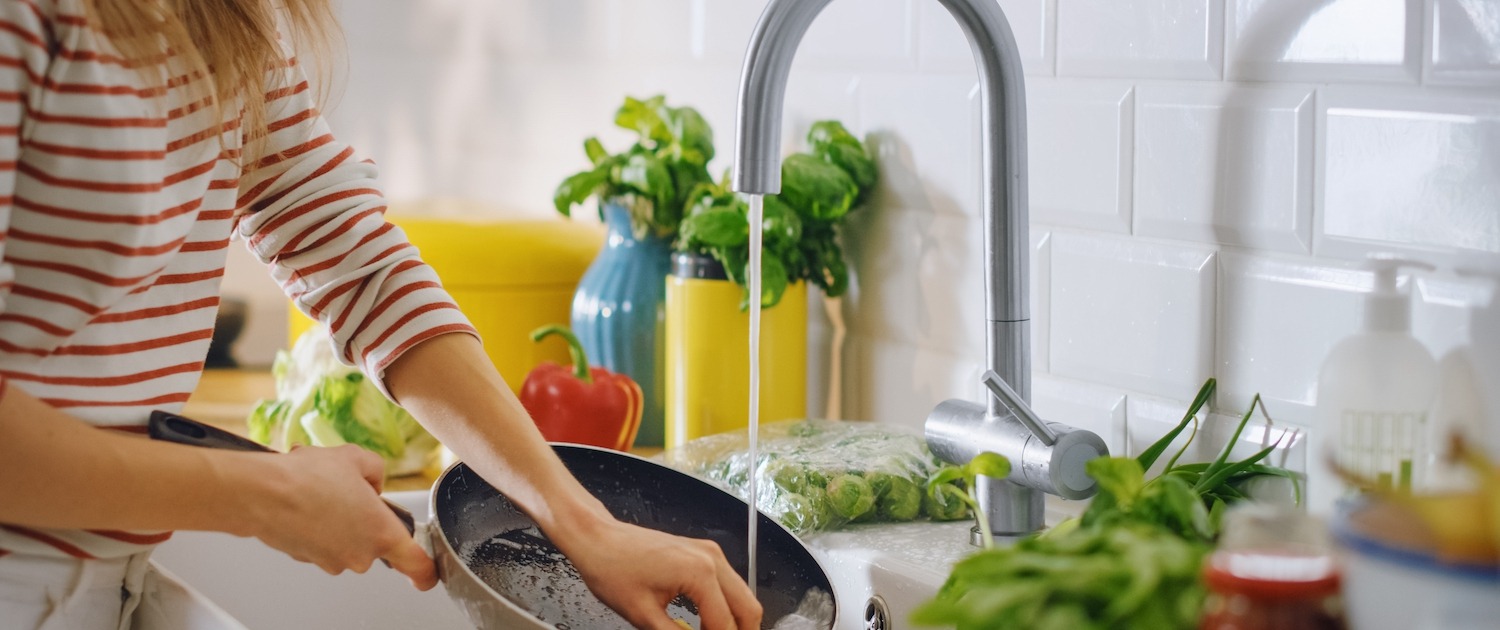How to Wash Dishes: By Hand or By Dishwasher
APP Expert / Friday February 25, 2022
Tired of spending endless hours scrubbing dishes by hand, only to feel like you’re just not getting the results you want? Discover how to streamline your dishwashing routine, save time, and conserve resources with our expert tips! Plus, don’t miss the step-by-step how-to video below for a visual guide to making your dish duty less of a chore and more efficient.
Need a replacement part for an appliance? Search below using your specific model number to identify the exact part needed:
Even if you have a top-of-the-line dishwasher, you probably own some items that can’t be added to a load. Stemware, cutting boards, wood utensils, and cast iron? They all need to be washed by hand, and in some cases in unique ways.
Nobody likes to stand hunched over a sink for an hour, but you can cut down on that time – and the amount of soap and water you use – with a good plan and a little bit of prep work. In this article, we’re walking you through all the best ways to get your dishes completely clean. Whether you’re washing by hand, or just loading the dishwasher up, knowing how to do it and what goes where will save you time and tedium.
Washing Your Dishes By Hand
1. Scrape And Organize.
Let’s start with some prep work. Getting things ready to go first is going to make washing the dishes a lot faster (and less gross) when you finally get to it. So, begin by getting everything out of the sink – cluttering up your workspace is only going to make it more of a pain. Set things on a nearby counter temporarily, and then work on getting any big chunks of food, puddles of grease, or piles of sauce off of your dishes and into the trash.
As you do this, reorganize what you’ll be washing into order beside the sink. Keep items with less crud and things like glasses closer to the sink. You’ll be washing those first. Then the slightly more soiled plates, bowls, and silverware, and finally any pots, pans, or other large items.
2. Prep Your Workspace
Don’t worry, we’re almost to actually washing the dishes. First, though, you need to prep your workspace. What style of sink you have and how much space you have available will dictate what will be easiest. Clear the space around your sink, and don’t load up the sink basin. You’ll want plenty of room on both sides of your sink to hold dirty and clean dishes. If you have one, set your drying rack out now. No matter what size space you’re working with, consider using a dedicated container for clean, sudsy water. A bowl or a mug – something big enough to hold your sponge or scrubber – with a bit of dish detergent and a couple of inches of water works wonders and will save you from burning through your dish soap. Set your soap cup on the corner of the sink. Now, you dip the rinsed sponge or scrubber into your receptacle of soapy water to suds things up. Your soapy water will stay cleaner because no dirty dishes are directly touching it, and you aren’t constantly squirting more dish soap on your sponge each time you need to soap things up again. You don’t necessarily need a whole wash basin full of water! The cup or bowl of soapy water should be enough to get everything clean without needing a ton of water in your sink basin. If you do need to soak, use your wash basin for that – or, if you have a large bowl or roasting pan that already needs to soak, it can act as a basin for other items in need of some time in warm soapy water.
3. Time To Clean!
Finally! If you aren’t working with a sink already full of water or dirty dishes on your dish drainer, you’ll be dipping your sponge into your soapy reservoir, scrubbing everything in the otherwise empty sink, and then rinsing it all as you go. This should overall cut down on the amount of time you spend standing at the sink. Start with smaller and less dirty items: utensils, glassware, plates and bowls without much crud on them. Next, move on to your more heavily soiled plates, bowls, and other medium-sized kitchen gear. As you clean, you may find that running some very hot water over stuck-on gunk is enough to loosen it up so you don’t need to wait on a lengthy soak. Set your freshly rinsed items aside on a clean dish towel or drying rack as you go. If the space fills up, pause to hand dry and put things away. Finally, get the big stuff. Pots, pans, mixing bowls, and cutting boards. Keep an eye on your reservoir of soapy water. If the suds are going flat, or if the water is starting to look dirty, you should refresh it. You can dump the used water into a waiting dirty pan or bowl to give it a mini-soak.
4. Wipe Down Your Sink
Once you’re done with the washing, wipe down your sink and give it a rinse. Wipe around the sink and under your dish rack with a paper towel. Even if you have a disposal, you be mindful that you don’t push anything potentially harmful down the drain. Toss anything that could damage your disposal or clog your drain in the trash.
5. To Dry Or Not To Dry?
Air drying is perfectly reliable, but you may need to towel dry some items and put them away to make more room if you’ve got a big load of dishes to clean. If you’re really strapped for space, you can use your dishwasher as a temporary drying rack, too. Don’t just let everything sit, though. Put things away once they’re dry so they don’t collect dust or become a new source of clutter.
How to Use and Load the Dishwasher
Used correctly, a dishwasher can seriously cut down the amount of time you spend scrubbing, but knowing how to load your dishwasher isn’t just about getting your cutlery cleaner – it’ll extend the life of your appliance, as well.
1. Know what can’t be put in the dishwasher. Glass stemware, wooden utensils, certain plastic containers, most teflon pans, all cast iron cookware, sharp knives (butter knives are fine), and cutting boards all risk damage when run through the dishwasher.
2. Don’t overload. You may think you’re saving on water or time by stuffing your dishwasher to bursting, but you’re more likely to see dirty dishes after a cycle has ended.
3. Don’t underload, either, though. Every time you run your dishwasher, you’re wearing down its mechanical parts a little more. Cut down on that and your overall water use by only running the dishwasher when it’s full.
4. Use the correct amount of dishwasher detergent. Too much could leave you with a sudsy kitchen disaster or just an unpleasant film on your dishes.
5. Scrape off the big chunks of food debris, but you don’t need to rinse everything. You can run a rinse-only cycle if you think you need to – it’s more water efficient than rinsing everything by hand.
6. Start in the back and work toward the front when loading. It’ll make fitting things a little easier.
- The top rack is for: cups, mugs, glasses, and smaller items like ramekins, dishwasher-safe plastic containers, bowls, and bulkier utensils.
- The bottom rack is for: plates, bigger bowls, and other large items. Be realistic, though. If you put a cookie sheet in there, you’re probably going to block half the load from getting clean.
- As for the silverware basket, load forks and spoons with the handles down, and knives handle up. Mix utensils in each bin to avoid alike flatware nesting together during the wash and winding up dirty.
- Point everything toward the spray arms. Cups, bowls, and containers should all be pointed down. Dishes should be loaded to face toward the center if possible.
- When emptying, start from the bottom and work up. The cups and glasses up top have concave bottoms, pointed up. They’ve likely collected water. If you clear out the bottom first, you won’t wind up dumping residue-y water on your plates and things when you empty the top.
Basic Tips To Keep Things Clean
- Don’t tackle everything all at once. If you just can’t seem to bring yourself to do an ever-growing load of dirty dishes, break it down into smaller bits and find a method that works for you:
- Clean as you go. If you’ve got something on the stove or in the oven that doesn’t need your full attention or working in steps, cleaning as you go will make tackling what’s left at the end less daunting.
- Wash one thing every time you step in the kitchen. Every cleaned casserole dish counts!
- Wash as many things as you can while you wait on something else. Brewing coffee, reheating leftovers, or waiting on water to boil for your instant ramen? Get some pots and pans washed while you wait.
- Set a brief timer and work in increments. Set yourself a timer for 15 to 25 minutes, wash as much as you can in that time, and then take a break.
- Scrape and rinse as soon as you’re done eating. You don’t need to clean the plates right away, but scraping off any leftover food particles and lightly handwashing dishes with dish liquid right after you eat will make your life easier later. Be kind to your future self!
- Don’t be too hard on teflon. Use a soft scrubber or sponge when you clean your teflon cookware, and don’t scrape anything on it too hard. You’ll risk peeling up the coating, which will make it potentially unsafe to use.
- You can multitask while you clean. Put on some music or your favorite podcast. It’ll make just about any chore go a whole lot faster.
- Wear dishwashing gloves. If pruney fingers or potential skin irritation are driving you away from getting your dishes done, donning a pair of rubber gloves will solve the problem. Not very fashionable, no, but sometimes we have to look like a mad scientist for 40 minutes to save our whole home from a potential fruit fly infestation.
- Keep a dedicated sponge or scrubber for your sharp knives. If you’ve got some of those nice, extra sharp kitchen knives, you know that your cleaning tools get beat up a whole lot faster when you clean them. Keep a dedicated set for your sharp kitchen tools to cut down on how quickly you burn through sponges.
- Clean your dishwasher regularly, too! Your dishwasher is usually great at killing mold and mildew, but it can still eventually get clogged up by food debris. Check out our guide to cleaning your dishwasher. You may find that your dishes come out a bit cleaner once you’ve given your appliance a good scrub down.
- Got a garbage disposal? You can clean that, too! Keeping your disposal clean will prolong its life, and eliminating those disposal odors can make the entire dishwashing ordeal a whole lot more pleasant.
Wrapping Up
Doing the dishes isn’t necessarily ever going to be fun, but there are plenty of ways to make it faster and more efficient. We hope we’ve helped to make a tedious task more manageable with this guide, and if you’re looking for more advice, keep us in mind the next time you need tips, tutorials, or genuine OEM replacement parts.
If you need any replacement parts for your appliances, you can enter your model number at AppliancePartsPros.com to locate and order them quickly. Most orders arrive in just two business days, and we have tons of great information in our repair help section and YouTube videos to help you troubleshoot.
Stay connected with the latest DIY tips, tutorial videos, and repair guides by following us on Facebook, Instagram, and Twitter. We love hearing about your repair stories and successes. If you need more help or want personalized guidance, feel free to contact or call us at 877-477-7278. We’re ready to help you take on your next project with confidence!
Since 1999, AppliancePartsPros.com has helped millions of people repair their broken appliances by providing high-quality original parts at well below retail prices, free support and troubleshooting, and award-winning customer service from an expert, friendly, US-based customer support team!
Hi! I’m Matt H., and I’m thrilled to be your guide through the world of appliance repair with over 25 years of invaluable experience in the industry.
From the early days of my career, I have been deeply passionate about appliances and their inner workings. Over the years, I’ve seen it all – from vintage models to the latest cutting-edge technology – and I’ve dedicated myself to mastering the art of repair. With a toolbox in one hand and a wealth of knowledge in the other, I’ve tackled every challenge that has come my way, learning and growing with each repair.
Join me as we dive into the intricacies of appliance repair. From step-by-step repair guides to explanations of common problems and their solutions, I’ll be here to simplify the repair process and empower you with the knowledge you need to keep your appliances running smoothly.
Feel free to explore our blog, ask questions, and leave comments – this platform is a space for learning, sharing, and growing together. Let’s work together to ensure that your appliances continue to serve you for years to come.
Thank you for joining me on this journey, and I look forward to being your go-to resource for all things related to appliance repair!





